

Find Apartments for Rent and Rentals - Get Your Walk Score. Walk Score. Walk Score is a private company that provides walkability services and apartment search tools through a website and mobile applications.
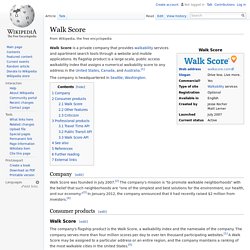
Its flagship product is a large-scale, public access walkability index that assigns a numerical walkability score to any address in the United States, Canada, and Australia.[1] Company[edit] Walk Score was founded in July 2007.[2] The company's mission is "to promote walkable neighborhoods" with the belief that such neighborhoods are "one of the simplest and best solutions for the environment, our health, and our economy. "[3] In January 2012, the company announced that it had recently raised $2 million from investors.[4] Consumer products[edit] Walk Score[edit] The company's flagship product is the Walk Score, a walkability index and the namesake of the company.
Josh Herst, CEO of Walk Score, has stated that he wants Walk Score to be a part of every real-estate listing in the future. Other features[edit] Zero Waste Home: Tips. My family of four generates a quart-size jar of waste per year, and so can you!
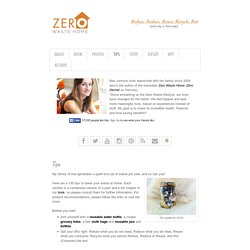
Here are a 100 tips to lower your waste at home. Each section is a condensed version of a post and a full chapter in my book, so please consult them for further information. For product recommendations, please follow the links or visit the store. Before you start: Use 100% recycled and unbleached toilet paper individually wrapped in paper (if you have solar you could install an electrical washlet to your toilet seat).Use an alum stone or straight baking soda as antiperspirant.For shaving, (re)use a safety razor and shaving soap (any rich soap, such as Alep soap will do).Refill your bottles with bulk shampoo and conditioner.
Stick to minimal wardrobes, shoes and purses.Only shop a couple times a year to avoid compulsive buys.Buy second-hand clothing If you must buy new, buy quality with minimal tags (leave the shoe box at the store). Earthbag Building: La Casa Vergara. This residence was designed by José Andrés Vallejo and built in Bogotá, Colombia in just 5 months, early in 2011.
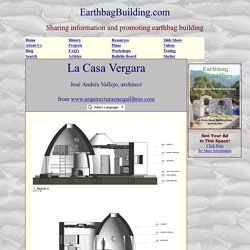
Architecture in Balance is a design platform that specializes in sustainable architectural solutions. Architecture in Balance implements alternative technologies, construction of low environmental impact, integrating contemporary design to create innovative projects and balanced environments. Architecture in Balance encourages the use of unprocessed construction materials such as soil, and uses different methods such as superadobe systems, among others. The design of La Casa Vergara explores the potential of seismic resistance with superadobe as the construction technology and contemprary design. The use of earth as a predominant structural element has practically disappeared, but this technique developed by Iranian architect Nader Khalili in the 90's brings back this traditional material.
The superadobe uses three elements: earth/concrete, tubular bags and barbed wire. Dome Shaped Earth Bag House Keeps Residents Naturally Cool in Colombia. Colombian architect Jose Andres Vallejo is the inspired genius behind La Casa Vergara, an innovative dome-shaped residence built with sustainable earthbag solutions.
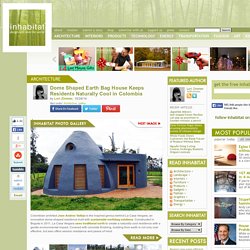
Constructed in Bogota in 2011, La Casa Vergara uses traditional earth to create a naturally cool residence with a gentle environmental impact. Covered with concrete finishing, building from earth is not only cost effective, but also offers seismic resistance and peace of mind. Building with earth is an ancient practice that has recently been updated to accommodate modern homes. Vallejo built this house using a system called Superadobe, which was originally invented by Iranian architect Nader Khalili and uses three main elements to create flexible living spaces- earth, tubular bags and barbed wire. At just $28 a square foot, the low cost is complemented by a gentle environmental impact, making for a promising architectural solution for low income areas.
Australian Man Builds Tiny, Solar-Powered Retreat Using Almost 100% Recycled Materials. The Tiny House Movement is gaining momentum worldwide and it's just received a big boost down under thanks to this recently completed tiny retreat on wheels.

Australian builder James Galletly, also known as The Upcyclist, teamed up with the Bower Reuse and Repair Center to design and build The Tiny, a small and cozy retreat constructed atop a box trailer and assembled with more than 95% recycled materials. Created as part of an educational exercise to expose Sydney residents to the concept of tiny living, the adorable one-bedroom space was completed in just 3 months and is perfect as a cozy artist's studio or backyard guesthouse. Galletly and The Bower realized early on that building a tiny house atop a 6×8 box trailer was nonviable, and so scaled back their plans to build a tiny bedroom instead. Constructed mostly from salvaged materials, the Tiny displays a one-of-a-kind feel on both its exterior and interior.
“The project is an experimental build,” writes Galletly. . + The Upcyclist. Why Building With Bottles Makes Sense. Here at Build Abroad, we have found that it is best to build with local materials.
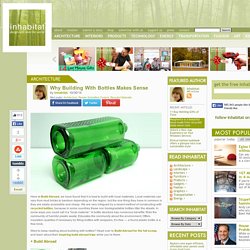
Local materials can vary from mud bricks to bamboo depending on the region, but the one thing they have in common is they are easily accessible and cheap. We are very intrigued by a recent method of constructing with recycled bottles, because in some countries these non biodegradable bottles litter the streets.